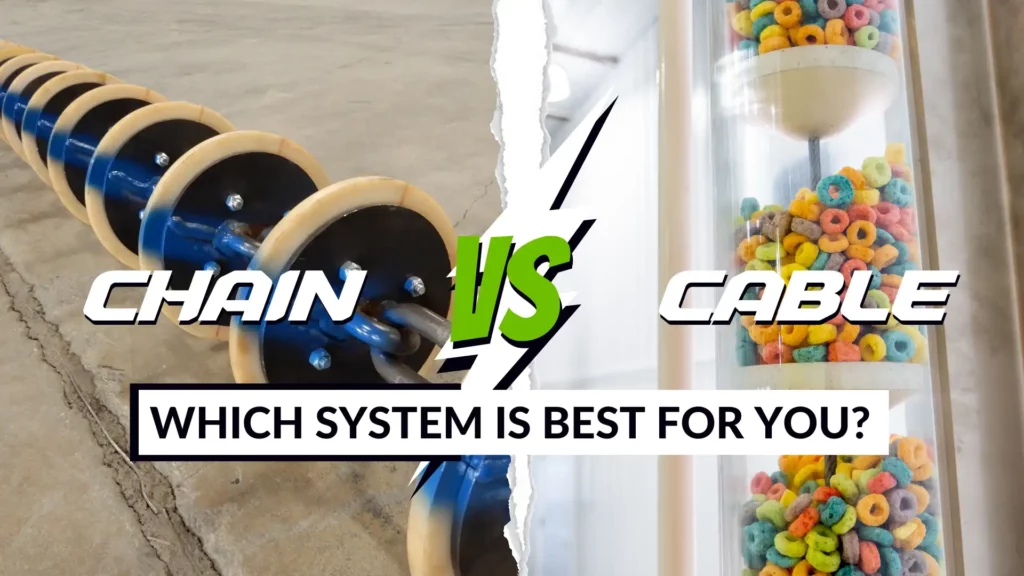Selecting the appropriate conveyor system is crucial for businesses that need to transport bulk items. There are two popular options – chain vs. Cablevey disc conveyors. Each has its pros and cons, but the final selection should be based on your particular requirements.
In this article, we’ll delve into the distinctions between these two systems, offering perspectives to assist you in deciding the right fit for your needs. Whether you’re transporting food, chemicals, or various other substances, this resource aims to empower you with the knowledge to choose the optimal machinery for your tasks.
What Are Tubular Drag Conveyors?
Tubular drag conveyors, also known as tubular disc conveyors, are a type of mechanical conveying system to transport bulk materials such as granules, powders, and pellets through a series of closed tubes. The tubes are connected together to form a continuous loop that runs between the inlet and outlet of the conveyor.
As the chain or cable moves through the tubes, it pulls the material along with it, creating a clean and efficient method of bulk material handling. Chain and cable are the two most popular types of tubular disc conveyors.
Chain Disc Conveyors
Chain conveyors use a loop of interconnected chains with close-running discs spaced along its length to move the material through the conveyor. The chains are designed to withstand heavy loads and high temperatures, as they are typically made of high-strength steel.
This makes chain conveyors an ideal choice for transporting abrasive or heavy materials, as well as materials that require high-temperature handling. The throughput capacity of this system is capable of transporting dry food products up to 36,287 kg/h.
Two Options You Can Choose From
There are two types of chains that can be utilized in chain disc conveyors – link chain and roller chain. The link chain can function as a universal joint during the movement of the product in the tube, allowing a single conveyor to alter directions in multiple planes.
The roller chain consists of linked plates fastened together with pins and bushings that allow movement only in one direction. The typical material for both types of chains is type 316 stainless steel due to its resistance to corrosion and acid, though carbon steel is also available.
Cablevey Disc Conveyors
Cable conveyors use a high-strength cable to drag the material through the conveyor. Most tubular drag conveyors use wire strand core cable (composed of type 316 stainless steel), which is commonly utilized in aircraft control functions due to the high-tensile strength that prevents it from breaking under normal conditions.
Such cable is often used in applications where cleanliness is essential, such as food processing or pharmaceutical production. A conveyor belt system is also highly versatile and can handle a wide range of materials, from fine powders to large pellets. It can transport a capacity of up to 36,200 kg per hour, moving at low speeds similar to chain conveyors, and it greatly minimizes product degradation.
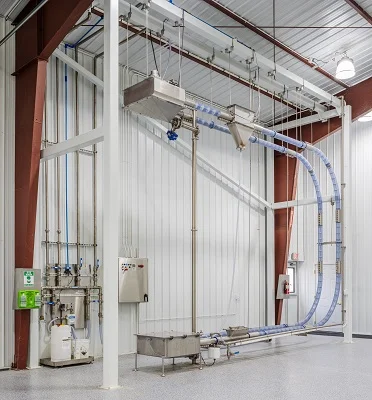
Chain vs. Cablevey Disc Conveyors – Explore Major Differences
Yes, a traditional belt conveyor system is the typical bulk material handling equipment, but you should definitely give chain or cable systems a try if you want to upgrade your business. Although both conveyors operate using similar principles, there are several key differences between them. Let’s explore them.

Cablevey Tubular Drag Equipment Offers Decreased System Downtime
Cablevey disc conveyors present multiple benefits compared to chain disc conveyors. Notably, they lead to less system downtime. Chain-based systems often demand regular upkeep, especially concerning chain tension fine-tuning and sprocket changes. Any misadjustments or degradation can cause the chain to detach from the sprocket or even snap, causing prolonged interruptions and costly fixes.
On the other hand, Cablevey systems have a reduced likelihood of malfunction thanks to their resilient and adaptable design that demands fewer upkeep tasks. Most tubular cable drag conveyors utilize wire strand cores (WSCs), commonly referred to as aircraft cables. These are composed of type 316 stainless steel wire cores enveloped by stainless steel woven cables. While there can be degradation of the wires and cables from friction, such issues can offset minor breakdowns in the immediate future.
Cable Disc Systems Have a Simpler but Durable Design
Due to their simpler yet durable design, Cablevey disc conveyors have fewer moving parts compared to chain systems, reducing the number of components that can fail or require replacement. This simplicity makes Cablevey systems easier to install and integrate into existing production lines, leading to lower downtime and maintenance costs.
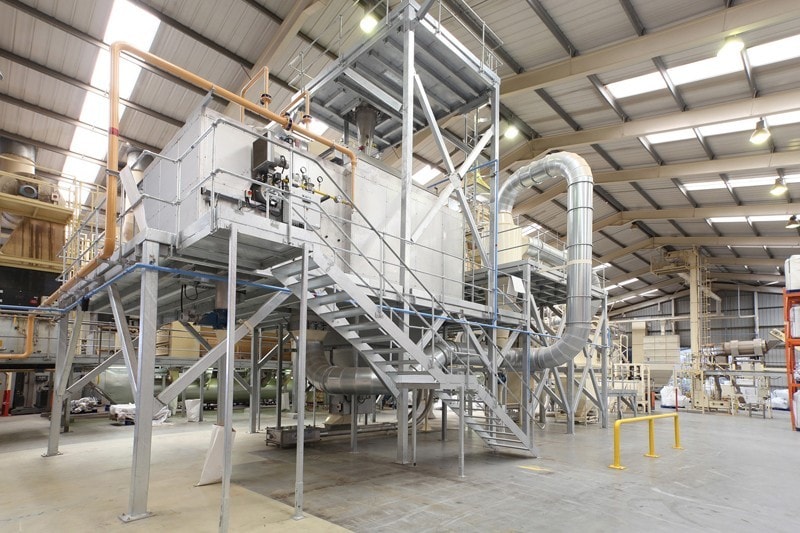
Be Aware of Some Possible Layout Challenges With Chain Systems
Both chain and Cablevey drag conveyors are popular choices for conveying materials in a wide range of industries, from food processing to pharmaceuticals. However, several layout challenges can arise during the installation process, especially when dealing with older facilities or smaller plants with lower ceilings. Let’s check them out:
- Size and weight – One of the main challenges with installing chain drag conveyors is their size and weight. These conveyors require a significant amount of space and support, which can be difficult to accommodate in smaller or older plants.
- Integration – This equipment can be more challenging to integrate into existing product lines, as it may require modifications to the layout or infrastructure of the facility.
- Straightforward path – Unlike cable drag conveyors, which are flexible and can be easily routed around obstacles, chain drag conveyors require a more straightforward path with fewer turns.
- Linear or L-shaped configuration – This means that their layout may be limited to a more linear or L-shaped configuration, which can be challenging for facilities with complex layouts or limited space.
Cablevey Conveyors Are Lightweight and Require Minimal Support
Their low-profile design makes them a great option for plants with lower ceilings or limited space. Furthermore, Cablevey conveyors can be customized to fit existing layouts, so there is no need for costly infrastructure modifications (unlike a traditional conveyor belt for a warehouse). Overall, Cablevey tubular drag conveyors offer a more efficient and cost-effective solution for conveying materials in a wide range of facilities.
In the video below, you can find a bit more information about how the Cablevey conveying system operates.
Cablevey Uses Smooth Movement of the Product, Preventing the Material Breakage
In food processing applications, maintaining the quality and integrity of the product is crucial. One factor that can significantly impact a product’s quality is the breakage of the material during the process of conveying. Cablevey disc conveyors use a flexible stainless-steel cable with solid circular discs attached to it, providing a gentle and smooth movement of the product through the tube.
This flexibility allows for seamless integration with various food production processes, from raw material reception to weighing, filling, grinding, and packaging. Unlike the traditional industrial conveyor belt chain systems, the Cablevey system’s design reduces friction and abrasion, preventing damage or breakage to the product during conveying.
Chain Systems, on the Other Hand, Use a Chain With Solid Circular Discs Attached to It
The friction and abrasion caused by this design can damage or break the product during conveying. This makes chain systems a less-than-ideal solution for fragile food, where contamination or dust accumulation is a problem, such as filling and packaging operations.
By reducing material breakage and damage, Cablevey disc conveyors can help maintain the quality and appearance of the product, increasing customer satisfaction and reducing waste. Cablevey’s system is also more hygienic, reducing the risk of contamination and ensuring product safety.
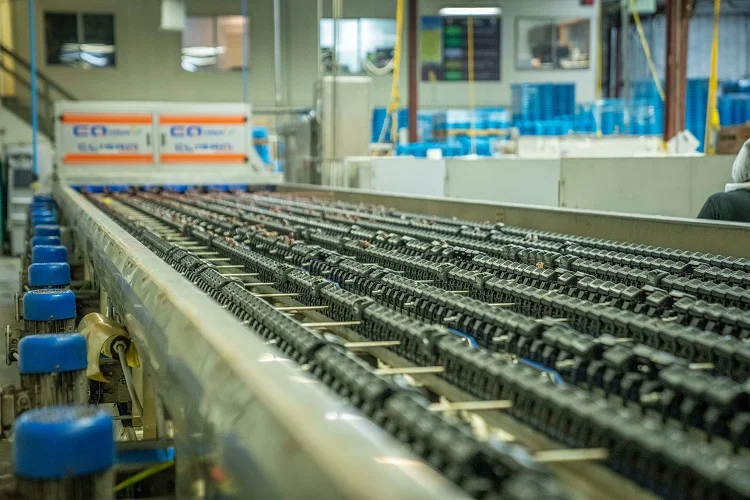
Cablevey’s System Provides Superior Sanitation and Food Safety
As previously mentioned, Cablevey’s system is superior to chain disc conveyors (not to mention a traditional custom conveyor belt) in terms of hygiene, as it effectively minimizes the risk of contamination and ensures the safety of the conveyed products. But how does it achieve this? First, we need to explain why food safety is so important.
The Significance of Sanitation
Maintaining food safety is critical in the food processing industry, as it can have severe consequences for public health and the reputation of businesses. If food particles become trapped during the manufacturing process, it can lead to numerous health and business risks, such as bacterial growth, food spoilage, food poisoning, non-compliance with regulatory standards, product recalls, and damage to a company’s image.
To avoid these hazards, food processing facilities must take necessary steps to prevent trapped food particles. The United States has various regulatory bodies responsible for ensuring food safety, including:
- US Food and Drug Administration (FDA) – oversees food supply safety,
- The US Department of Agriculture (USDA) – regulates the safety of meat, poultry, and egg products,
- The Occupational Safety and Health Administration (OSHA) – aims to protect food processing facility workers’ safety and health.
Cable Conveyor Systems Ensure Smoother Cleaning
Although both systems are designed to meet sanitation standards set by the FDA, there are some differences between the two in terms of their ability to prevent contamination and facilitate cleaning.
- Chain systems have a roller chain or a polished stainless steel conveyor link that is corrosion and acid-resistant. While the chains are designed to be easy to clean, cleaning the entire chain can be challenging since it is immersed in the food being conveyed.
- The roller chains have plates, pins, and bushings that can trap food particles, and water can get trapped in these spaces, providing a breeding ground for bacteria. To avoid this, cleaning mechanisms such as brush boxes, chain knockers, and wet clean-in-place (CIP) systems are available to minimize the accumulation of food particles.
- Cablevey systems, on the other hand, use a stainless steel cable with solid circular discs attached to it. The cable is entirely uniform and smooth throughout its entire route within the tube, minimizing the possibility of trapping food residue.
- The stainless steel cable used in Cablevey systems is entirely nylon-sealed, ensuring that no debris accumulates within the strands of the cable. Cablevey systems also offer more cleaning options, including brush boxes, air knives, urethane wipers, inline bristle brushes, inline sponges, and multi-step CIP (self-cleaning) wet cleaning.
Chain Systems Have More Power Consumption
Cable conveyors have one significant advantage over chain conveyors, and that is their superior energy efficiency. The weight of chains used in chain conveyors makes them heavier and requires more energy to operate than cable systems. In fact, chain conveyors often require larger motors and more power than their cable counterparts.
This not only adds to the initial cost of the system but also increases ongoing expenses, including higher energy bills and maintenance costs. In contrast, cable drag conveyors require less energy to operate, resulting in lower energy bills and reduced maintenance costs over time.
Go Green With Cablevey
Furthermore, the use of cable conveyors also supports environmental sustainability as they consume less energy and, therefore, have a smaller carbon footprint. So, when choosing a conveyor system, it’s important to consider not just the initial cost but also the ongoing expenses like power bills, maintenance costs, and compliance with safety regulations. In this regard, cable drag conveyors emerge as a better option, providing energy efficiency, lower costs, and sustainability.
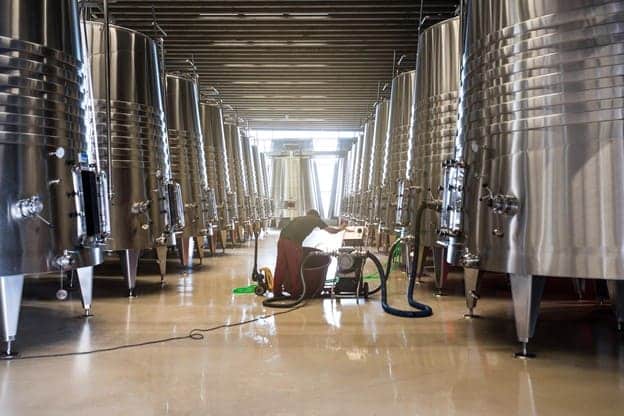
Choosing the Perfect Conveyor System Hinges on Your Business’s Unique Demands
With chain conveyors ruling the realm of heavy, abrasive material handling and cable conveyors excelling in purity and adaptability, the choice may seem complex. Yet, the litmus test often rests on system reliability and energy efficiency. The frequent maintenance and resultant downtime of chain systems can burn a hole in your pocket, whereas Cablevey systems stand out for their durability, reducing operational hiccups and being gentler on power consumption. So, if you’re scouting for a conveyor that’ll seamlessly blend into your food processing hub, the answer might lie in tubular cable and disc systems. Reach out to Cablevey Conveyors, and let’s embark on a journey to find the conveyor tailor-made for your facility!

